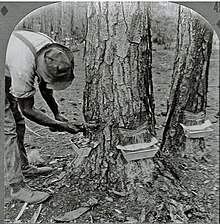User:Bmattei1225/sandbox
 | This is a user sandbox of Bmattei1225. You can use it for testing or practicing edits. This is not the sandbox where you should draft your assigned article for a dashboard.wikiedu.org course. To find the right sandbox for your assignment, visit your Dashboard course page and follow the Sandbox Draft link for your assigned article in the My Articles section. |
 Chemical structure of pinene, a major component of turpentine
| |
| Identifiers | |
|---|---|
| EC Number |
|
| UNII | |
| Properties | |
| Appearance | Viscous liquid[1] |
| Odor | Resinous[1] |
| Hazards | |
| GHS labelling: | |
    [2] [2]
| |
| Danger | |
Except where otherwise noted, data are given for materials in their standard state (at 25 °C [77 °F], 100 kPa).
| |
Turpentine
Turpentine (also called Chian ,Scio, Cyprian )[3]Impulsive powerful gum turpentine oil naturally derived from live pine trees: has been for decades. After a long and through distillation process its ready for use. Mainly used a solvent in paint, history and research shows it also has health benefits and can be used a medicine. Turpentine is an antiseptic, and it has a strong odor and a terrible taste.[4]It has a distinct sandalwood odor it is known to perfumers as Osyrol. Oleoresin is another word used but is gum turpentine. Longleaf pine is a term used to describe pinus palustris and other pinus species; they all fall under the same the category of were turpentine can be distilled from. There three different forms of turpentine gum, wood, and sulfate. Wood turpentine is attained by extraction of virgin pine stumps from which the sapwood has rotted away.



One of the earliest sources was the terebinth or turpentine tree (Pistacia terebinthus), a Mediterranean tree related to the pistachio. Important pines for turpentine production include: maritime pine (Pinus pinaster), Aleppo pine (Pinus halepensis), Masson's pine (Pinus massoniana), Sumatran pine (Pinus merkusii), longleaf pine (Pinus palustris), loblolly pine (Pinus taeda) and ponderosa pine (Pinus ponderosa).
Canada balsam, also called Canada turpentine or balsam of fir, is a turpentine which is made from the oleoresin of the balsam fir. Venice turpentine is produced from the western larch Larix occidentalis.
To tap into the sap producing layers of the tree, turpentiners used a combination of hacks to remove the pine bark. Once debarked, pine trees secrete oleoresin onto the surface of the wound as a protective measure to seal the opening, resist exposure to micro-organisms and insects, and prevent vital sap loss. Turpentiners wounded trees in V-shaped streaks down the length of the trunks to channel the oleoresin into containers. It was then collected and processed into spirits of turpentine. Oleoresin yield may be increased by as much as 40% by applying paraquat herbicides to the exposed wood.[5]
The V-shaped cuts are called "catfaces" for their resemblance to a cat's whiskers. These marks on a pine tree signify it was used to collect resin for turpentine production.[6]
Converting oleoresin to turpentine
[edit]Crude oleoresin collected from wounded trees may be evaporated by steam distillation in a copper still. Molten rosin remains in the still bottoms after turpentine has been evaporated and recovered from a condenser.[5] Turpentine may alternatively be condensed from destructive distillation of pine wood.[7]
Oleoresin may also be extracted from shredded pine stumps, roots, and slash using the light end of the heavy naphtha fraction (boiling between 90 and 115 °C or 195 and 240 °F) from a crude oil refinery. Multi-stage counter-current extraction is commonly used so fresh naphtha first contacts wood leached in previous stages and naphtha laden with turpentine from previous stages contacts fresh wood before vacuum distillation to recover naphtha from the turpentine. Leached wood is steamed for additional naphtha recovery prior to burning for energy recovery.[8]
When producing chemical wood pulp from pines or other coniferous trees, sulfate turpentine may be condensed from the gas generated in Kraft process pulp digesters. The average yield of crude sulfate turpentine is 5–10 kg/t pulp.[9] Unless burned at the mill for energy production, sulfate turpentine may require additional treatment measures to remove traces of sulfur compounds.[10]
Health Benefits
[edit]Turpentine oil can be applied topically to skin to relieve such pains as joint pain, muscles pain, nerve pain, toothaches, and disseminated sclerosis. [11]It also benefits were it can treat rheumatoid and neuralgic disorders and disseminated sclerosis. Quite a few drops of the oil are generally rubbed onto to the affected area. Breathing in the vapors of turpentine oil can decrease thick oozing caused by bronchial diseases. 100% pure gum turpentine could be used to remove parasites from your body.
History
[edit]It is one of the oldest and most widely used in industrial solvents. It was mainly used in South America. For many years, it was mandatory that slaves had to do the difficult, thorough work of making turpentine. Turpentine was used medically during the Civil War. Two Centuries ago North Carolina was the state known to give turpentine to the world with its breakout expansion of long leaf pine.
Industrial and other end uses
[edit]Solvent
[edit]The two primary uses of turpentine in industry are as a solvent and as a source of materials for organic synthesis. As a solvent, turpentine is used for thinning oil-based paints, for producing varnishes, and as a raw material for the chemical industry. Its industrial use as a solvent in industrialized nations has largely been replaced by the much cheaper turpentine substitutes distilled from crude oil. Turpentine has long been used as a solvent, mixed with beeswax or with carnauba wax, to make fine furniture wax for use as a protective coating over oiled wood finishes (e.g., tung oil).
Source of organic compounds
[edit]Turpentine is also used as a source of raw materials in the synthesis of fragrant chemical compounds. Commercially used camphor, linalool, alpha-terpineol, and geraniol are all usually produced from alpha-pinene and beta-pinene, which are two of the chief chemical components of turpentine. These pinenes are separated and purified by distillation. The mixture of diterpenes and triterpenes that is left as residue after turpentine distillation is sold as rosin.
Medicinal elixir
[edit]Turpentine and petroleum distillates such as coal oil and kerosene have been used medicinally since ancient times, as topical and sometimes internal home remedies. Topically, it has been used for abrasions and wounds, as a treatment for lice, and when mixed with animal fat it has been used as a chest rub, or inhaler for nasal and throat ailments.[12] Many modern chest rubs, such as the Vicks variety, still contain turpentine in their formulations.
Turpentine was a common medicine among seamen during the Age of Discovery. It is one of several products carried aboard Ferdinand Magellan's fleet in his first circumnavigation of the globe.[13] Taken internally it was used as a treatment for intestinal parasites. This is incredibly dangerous, due to the chemical's toxicity.[14][15]
Uses
[edit]Is most recognized for its use as a cleaning and diminishing property, it is also common in other industries. Distilled turpentine oil is used as a flavor enhancer ingredient in foods and beverages[16]Manufacturing turpentine oil is used as a paint solvent; aids the paint in coating, bonding, and penetrating all types of wooden surfaces. It also fund as an ingredient in cosmetics and soap, used as well for the thinning process. Anti-bacterial properties of turpentine make it an outstanding high-quality for sanitation. Although for many years it has been used as a medicine, it was used many years also as a water repellent, paint thinner, and solvent. Oil and gas lamps can also be powered by turpentine oil.It can be used to lubricate certain equipment used by industrial workers. [17]
Hazards
[edit]| NFPA 704 safety square | |
|---|---|
Where here are health benefits there are hazards as well. Insects will die instantly if exposed to the oil. Turpentine oil is safe to inhale. Safest way to inhale the vapors is use several drops of the oil into hot water. It is safe to use the recommend dosage when applying to the skin topically. It can become very flammable when not used with caution for use a torch.
See also
[edit]- Charles Herty
- Galipot
- Naval stores industry
- Patent medicine
- Retsina
- Russia leather, a water-resistant leather, using a birch oil distillate similar to turpentine in its manufacture.
Sources
[edit]- Kent, James A. Riegel's Handbook of Industrial Chemistry (Eighth Edition) Van Nostrand Reinhold Company (1983) ISBN 0-442-20164-8
References
[edit]- ^ a b Record in the GESTIS Substance Database of the Institute for Occupational Safety and Health
- ^ "Turpentine". European Chemicals Agency.
- ^ Gorrell, Michael Gorrell (2011). "E-books on EBSCOhost: Combining NetLibrary E-books with the EBSCOhost Platform". Information Standards Quarterly. 23 (2): 31. doi:10.3789/isqv23n2.2011.07. ISSN 1041-0031.
- ^ Ewbank, Anne (2018-03-26). "The Long, Strange History of Medicinal Turpentine". Atlas Obscura. Retrieved 2019-05-14.
- ^ a b Kent p.571
- ^ Prizer, Tom (June 11, 2010). "Catfaces: Totems of Georgia's Turpentiners | Daily Yonder | Keep It Rural". dailyyonder.com. Retrieved June 5, 2012.
- ^ Kent p.569
- ^ Kent pp.571&572
- ^ Stenius, Per, ed. (2000). "2". Forest Products Chemistry. Papermaking Science and Technology. Vol. 3. Finland. pp. 73–76. ISBN 952-5216-03-9.
{{cite book}}: Cite has empty unknown parameter:|lay-date=(help)CS1 maint: location missing publisher (link) - ^ Kent p.572
- ^ "Turpentine Oil Effectiveness, Safety, and Drug Interactions on RxList". RxList. Retrieved 2019-05-14.
- ^ "Surviving 'The Spanish Lady' (Spanish flu), 06:09, Residents of a small Alberta town recall their deadly brush with 1918's Spanish flu". CBC Digital Archives. 2003-04-10. Event occurs at 03:20.
A turpentine and hot water, and [wring hot towels out of there], and put it on their chest and back. --Elsie Miller (nee Smith)
{{cite web}}: Unknown parameter|lay-url=ignored (help) - ^ Laurence Bergreen (2003). Over the edge of the world : Magellan's terrifying circumnavigation of the globe. ISBN 0066211735. LCCN 2003050143. Retrieved 2009-09-14.
- ^ "Home Remedies - American Memory Timeline- Classroom Presentation". American Memory Timeline. The Library of Congress. Retrieved 2017-02-06.
- ^ http://www.inchem.org/documents/icsc/icsc/eics1063.htm
- ^ "Turpentine Oil Effectiveness, Safety, and Drug Interactions on RxList". RxList. Retrieved 2019-05-14.
- ^ "Turpentine". www.solvchemcustompack.com. Retrieved 2019-05-14.
External links
[edit]- Inchem.org, IPCS INCHEM Turpentine classification, hazard, and property table.
- CDC - NIOSH Pocket Guide to Chemical Hazards - Turpentine
- FAO.org, Gum naval stores: Turpentine and rosin from pine resin
- FloridaMemory.com, Florida State Archive photographs of turpentine camps and laborers
- HCHSonline.org, Timber and Turpentine Industries
- Distil my beating heart
- Florida's "Turpmtine" Camps
- Turpentine Industry at A History of Central Florida Podcast
Category:Household chemicals Category:Hydrocarbon solvents Category:Painting materials Category:Patent medicines Category:Resins Category:Terpenes and terpenoids Category:Papermaking Category:Non-timber forest products

